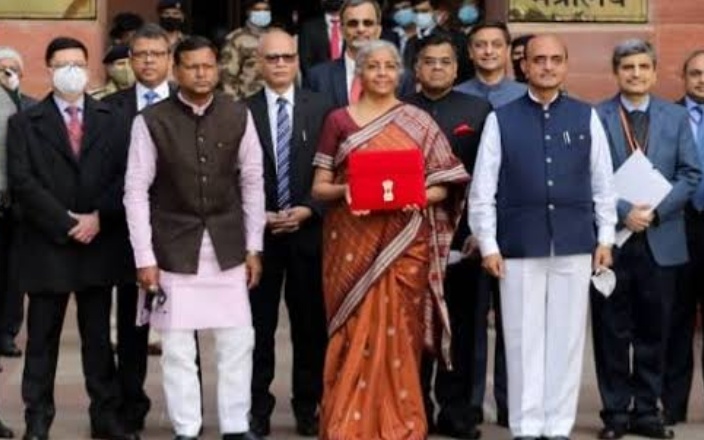The Union Budget has proposed Rs 2 lakh increase in Government capital expenditure and extended a Rs 1 lakh interest-free loan to states in order to target growth of 8.2 per cent in 2022-23.With anticipated growth of 9.2 per cent in the current fiscal, the economy would have recovered 101.3 per cent of the pre-pandemic output of 2019-20 by March 31, 2022.Hoping to evoke a matching response from the private sector to spur job creation, the Government extended the production linked scheme (PLI) to manufacturing of solar modules. The allocation of Rs 19,500 crore will add to the PLI announced for Rs 3,46,827 crore on these 14 PLI schemes. The Budget also extended for one year the concessional corporate tax of 15 per cent on newly incorporated manufacturing companies.
Presenting the Budget in Lok Sabha, the Union Finance Minister left personal income tax rates untouched, increased tax deductions for investments in national pension schemes for government employees but imposed a 30 per cent tax on income from virtual digital assets.In an attempt to enthuse the real estate sector, long term capital gains tax has been capped at 15 per cent instead of the earlier band of 15 to 35 per cent.There was little room for concession as the fiscal deficit for 2021-22 slipped by 0.1 per cent to 6.9 per cent and is projected at 6.4 per cent in 2022-23.
Moreover, interest payment and servicing of debt rose by Rs 1.26 lakh crore to nearly Rs 9.5 lakh crore in 2022-23.While sops for the middle class were few, the big picture from the Rs 39.50 lakh crore Budget was the increase in outlay for capital expenditure by 35.4 per cent to Rs 7.5 lakh crore in 2022-23 with Sitharaman claiming that the effective capital expenditure will be Rs 10.68 lakh crore, or 4.1 per cent of GDP.As joblessness became a concern and privatisation its subtext, the target from disinvestment for 2022-23 is a scaled down Rs 65,000 crore and instead of the Rs 1.75 lakh crore budgeted for 2021-22 , the realisation was Rs 78,000 crore.Of this, a hike of Rs 1 lakh crore is for extending National Highways by 25,000 km, an extra Rs 20,000 crore in capital expenditure for the railways and Rs 1.5 lakh crore for the defence sector. And, a Gati Shakti masterplan will guide big private investment in seven sectors of the Rs 100 lakh crore National Infrastructure Pipeline. These are roads, railways, airports, ports, mass transport, waterways, and logistics infrastructure.In a nod to the difficulties faced by the industry, the Budget announced the scrapping of anti-dumping duty on certain steel products from China.All talk of 100 smart cities in the earlier Budgets was replaced by the announcement of a high-level panel to be set up for urban planning, new and modern building by-laws and increased promotion of public transport in urban areas. Similarly, there was no mention of doubling farmers’ income. Instead the Budget spoke of “a wave of technology in agri sector” such as kisan drones, natural farming along the Ganga river corridor and interlinking of six rivers including the Rs 44,605 Ken-Betwa project.In the social sector, Rs 60,000 crore will be allocated for access to tap water to 3.8 crore households and 80 lakh houses will be completed in 2022-23 under PM Awas Yojana. The allotment for MNREGA remained nearly equal that of last year’s Rs 73,000 crore despite revised estimates for the current year coming at Rs 98,000.The newly-minted Ministry of Cooperation under Amit Shah received Rs 900-crore while the Alternate Minimum Tax (AMT) on cooperative societies was cut to 15 per cent and surcharge to 7 per cent.
No changes announced in the existing income tax slabs or rate.
Nirmala Sitharaman quoted shlokas (hymns) from the Shantiparva chapter of Sanskrit epic Mahabharata to say that the ruler should ensure people’s welfare and govern by following Dharma (sacred duty) from taxes collected from people.She said taxpayers could now file an updated income tax return if they missed out on certain information in the original form. This update on return will be voluntary and could be done within two years of filing of return.No changes were announced in the existing income tax slabs or rate. Later, Sitharaman told a press conference that the income tax slabs were left unaltered due to prevailing Covid-19 situation which impacted different income groups differently.Sitharaman announced reduction of Alternate Minimum Tax (AMT) rate for cooperative societies from 18.5 per cent to 15 per cent at par with companies. Surcharge on cooperative societies earning Rs 1-10 crore a year was also reduced to seven per cent.
She announced tax relief to persons with disabilities making parents or guardian eligible for benefits at 60. In another important announcement, tax deduction limit for NPS (National Pension Scheme) account of state government employees was increased from 10 per cent to 14 per cent at par with the central government employees.Union Budget 2022-23 capped the long-term capital gains (LTCG) surcharge at 15 per cent. The budget proposed to slash custom duty on cut and polished diamond to five per cent.Imported umbrellas became costlier as customs duty on such import was raised to 20 per cent. It is a move to help domestic umbrella makers as they are reported to be losing out in competition with the Chinese products.
RBI to introduce digital rupee in FY23 to boost digital economy, better currency management
The Reserve Bank of India (RBI) will introduce digital currency in the next financial year beginning April 2022 to boost the digital economy and efficient currency management, Finance Minister Nirmala Sitharaman proposed in her Budget 2022-23 speech on Tuesday.The introduction of a central bank digital currency will give a big boost to the digital economy. Digital currency will also help in the currency management system, the minister said.”Digital currency will also lead to a more efficient and cheaper currency management system. It is therefore proposed to introduce digital rupee using blockchain and other technologies to be issued by the Reserve Bank of India, starting 2022-23,” Sitharaman said.
She also said Rs 1 lakh crore financial assistance to states will be provided in 2022-23 to catalyse investments.The finance minister further said that in 2022-23, states will be allowed a fiscal deficit of up to 4 pc of GSDP (Gross State Domestic Product).The minister also proposed to set up an expert committee to examine and suggest appropriate measures to scale up venture capital and private equity investment.Venture capital and private equity invested more than Rs 5.5 lakh crore last year, facilitating one of the largest startup and growth ecosystems. Scaling up this investment requires a holistic examination of regulatory and other frictions, she said.On blended finance, she said that the government-backed Funds NIIF and SIDBI Fund of Funds had provided scale capital, creating a multiplier effect.For encouraging important sunrise sectors, such as climate action, deep-tech, digital economy, pharma and agri-tech, the government would promote thematic funds for blended finance with the government share being limited to 20 per cent and the funds being managed by private fund managers, the minister said.




